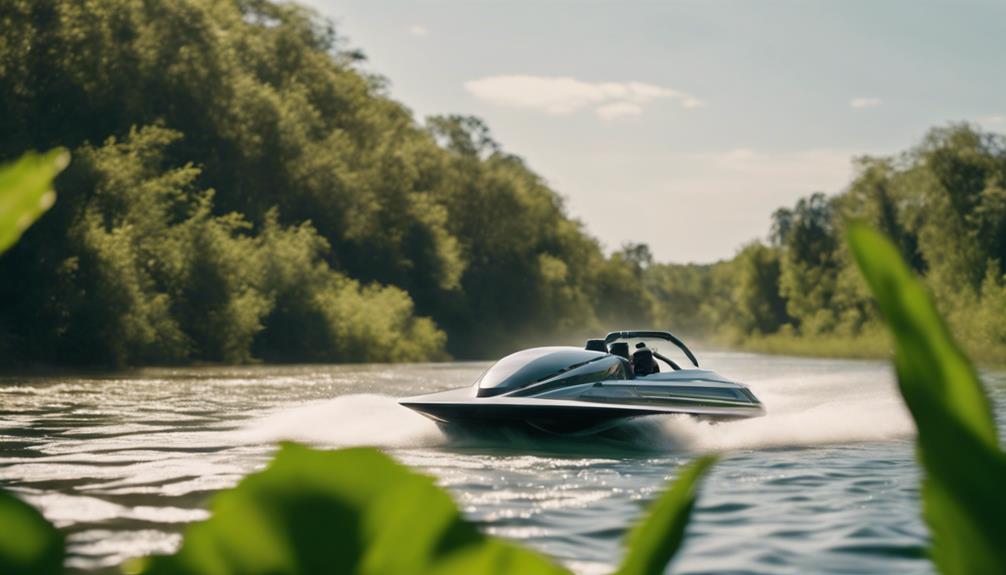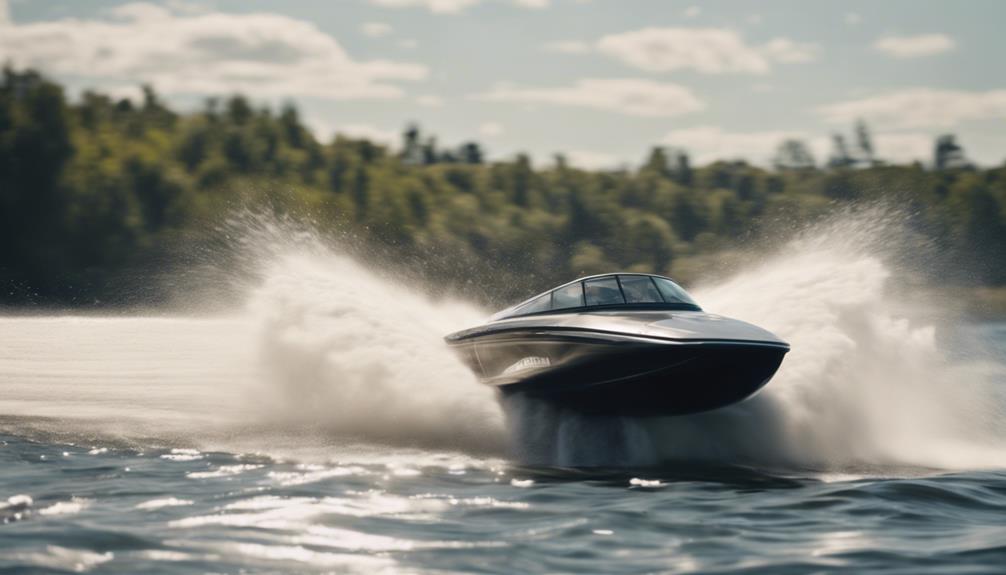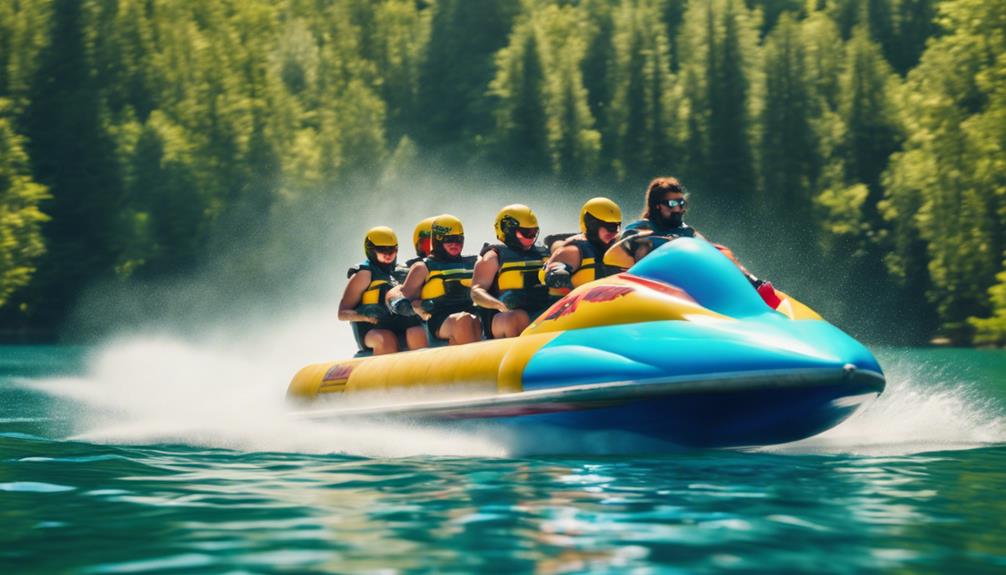Jet boats are excellent for shallow water navigation. With a draft as shallow as 3 inches, they allow you to explore hidden coves and narrow channels that other boats can't access. Their jet drive mechanism offers quick maneuverability and reduces the risk of propeller damage. However, you need to be cautious of debris, as it can clog the intakes. While they may consume more fuel, the versatility and safety features make them a popular choice for adventure on shallow waterways. Curious about their specific advantages and maintenance tips? There's more to discover about jet boats' performance!
Key Takeaways
- Jet boats can operate in as little as 3 inches of water, making them ideal for shallow water navigation.
- Their shallow draft allows access to narrow channels and hidden coves that traditional boats can't reach.
- The jet drive mechanism reduces the risk of entanglement with submerged objects, enhancing safety for swimmers and skiers.
- Regular maintenance is crucial to prevent clogging from debris, which can impede performance in shallow waters.
Jet Drive Mechanism
Jet boats use an impeller system to draw water from beneath the hull and expel it at high speed, creating thrust and allowing for traversal in shallow waters.
The jet drive mechanism is key to this functionality, enabling you to glide over areas with minimal water. With a shallow draft, jet boats can operate in as little as 3 inches of water, making them ideal for maneuvering through narrow channels and lakes.
The impeller draws water through an intake and forces it out through a nozzle, providing the thrust you need without relying on traditional propellers. This design not only enhances performance but also minimizes the risk of damage when you're in rocky or debris-filled waters.
Steering is equally responsive, as you can direct the water flow through a movable nozzle. This allows for quick adjustments, making your maneuvers smooth and effective.
Plus, the absence of an external propeller means you won't have to worry about entangling submerged objects, adding an extra layer of safety.
Advantages of Jet Boats

When you choose a jet boat, you're opting for a vessel that excels in shallow water navigation, thanks to its minimal draft.
You'll also benefit from enhanced safety features, like a safe design around the transom, making it perfect for swimming and water sports.
Plus, with versatile power options, these boats adapt easily to your adventure needs.
Shallow Water Navigation Benefits
Maneuvering shallow waters becomes effortless with a jet boat, which boasts a shallow draft that allows you to explore areas other boats can't reach. Typically ranging from 12 to 17 inches, this shallow draft means you can traverse in minimal water depth without risking damage to the propulsion system.
In fact, jet boats can operate in as little as 3 inches of water at full throttle, making them perfect for adventuring in shallow rivers and lakes.
Unlike traditional propeller-driven boats, jet boats are designed to reduce the risk of entanglement with submerged objects, enhancing your overall experience in shallow water. Their powerful impeller system delivers superior acceleration and maneuverability, giving you the edge when traversing tight or tricky spots.
Jet boats also increase your versatility on the water. Whether you're fishing, cruising for leisure, or exploring challenging waterways, their ability to operate efficiently in shallow conditions transforms your outings.
Enhanced Safety Features
One of the standout benefits of jet boats is their enhanced safety features, which help protect swimmers and skiers from potential injuries caused by exposed rotating propellers. Unlike traditional boats, jet boats utilize a contained jet drive impeller, considerably reducing the risk of accidents. This design allows you to enjoy your time on the water without worrying about injuries from spinning props.
In shallow waters, jet boats shine due to their shallow draft, which ranges from 12 to 17 inches. This feature means you can navigate rocky or sandy areas without the risk of grounding, providing enhanced stability. The jet pump system also delivers improved maneuverability and quick acceleration, ensuring safe handling even in tight spots.
Another safety advantage is the reverse thrust mechanism. This system repositions water flow, giving you better control when backing up in shallow waters compared to traditional propeller systems. With these enhanced safety features, you can confidently explore various waterways, knowing that your jet boat is designed to prioritize your safety and enjoyment.
Versatile Power Options
Jet boats offer versatile power options, allowing you to choose between single or dual engines to match your specific boating needs. This flexibility means you can opt for a lighter setup for casual outings or a more powerful configuration for exciting adventures. The compact design of jet engines not only contributes to a lighter overall weight but also makes towing and maneuvering easier.
One key advantage of jet boats is their jet pump system, which provides efficient thrust without an external propeller. This design considerably reduces the risk of entanglement with submerged objects, making jet boats a safer choice for steering through shallow waters. With a minimal draft ranging from 12 to 17 inches, these boats can glide effortlessly over shallow areas, increasing your access to hidden spots and serene coves.
Additionally, jet boats feature a reverse bucket mechanism that enhances their versatility in various water conditions, allowing you to maneuver with precision. Whether you're exploring narrow rivers or relaxing in shallow lakes, the adaptable power options and unique design of jet boats make them an excellent choice for any boating enthusiast.
Disadvantages of Jet Boats

While jet boats offer many benefits, they come with some notable disadvantages you should consider.
Clogging from debris can hinder performance, and handling in tight spaces, like docks, can be tricky.
Plus, you might find that jet boats consume more fuel than other options, adding to your operating costs.
Clogging From Debris
Clogging from debris poses a considerable challenge for jet boat users, as underwater obstacles can quickly impede performance and power. When you're maneuvering through shallow waters, the risk of clogging at the pump intake increases markedly. Weeds, leaves, and other debris can easily obstruct the jet drive, limiting your boat's thrust and efficiency.
If you're not careful, you might notice a substantial loss of power during your outings. Regular maintenance becomes vital to prevent this issue, as clogged intakes can damage the impeller, leading to potentially costly repairs. After each outing, it's important to inspect the intake area to verify it's free from debris.
Ignoring the risk of clogging can result in reduced operational reliability, which is something no jet boat owner wants to face. Ultimately, while jet boats can be great for shallow waters, you must remain vigilant about debris management.
Keeping your jet boat's intake clear is imperative for maintaining performance and prolonging the lifespan of your watercraft. So, if you're considering a jet boat, be prepared for the maintenance that comes with it.
Handling Difficulties at Docks
Maneuvering tight dock spaces can be particularly challenging for jet boat operators due to their reduced tracking ability at no-wake speeds. Unlike sterndrive boats, jet boats often struggle with precise control when moving slowly, making handling difficulties at docks a common concern.
The smaller steering nozzles on jet boats can complicate low-speed handling, requiring more skill and effort to navigate around tight corners and obstacles.
For inexperienced drivers, the situation can become even more problematic. Jet boats may drift forward in neutral, increasing the risk of collisions with surrounding structures or other boats. Additionally, the reverse gate mechanism used for backward movement doesn't always offer the same level of control as traditional propeller systems. This can lead to frustration and anxiety when trying to dock.
Without external propellers providing a rudder effect, you'll find that jet boats lack the maneuverability expected in close quarters. This limitation can make docking a nerve-wracking experience, especially if you're not familiar with the unique handling characteristics of jet boats.
Ultimately, if you're considering a jet boat, be prepared for these challenges when approaching docks.
Higher Fuel Consumption
Jet boats are known for their impressive shallow water capabilities, but they often come with a downside: higher fuel consumption. You might find that while these boats excel in maneuvering tight, shallow areas, the cost of operating them can add up quickly.
Here are some key points to take into account regarding higher fuel consumption in jet boats:
- Jet boats typically deliver about 40 hp of effective thrust from a 60 hp outboard jet due to efficiency losses.
- They generally consume more fuel at lower speeds, making them less economical for leisurely cruising.
- Their design requires more horsepower to match the speed and performance of propeller-driven boats, leading to increased fuel usage.
Jet Boats Vs. Sterndrive Boats

When comparing jet boats and sterndrive boats, you'll find that their design and operation considerably impact performance in shallow waters. Jet boats typically have a shallow draft, ranging from 12 to 17 inches, allowing them to navigate areas where sterndrive boats, with their deeper drafts, may struggle due to exposed propellers.
The propulsion systems also differ considerably. Jet boats use a jet pump system that draws water from beneath the hull, making them less vulnerable to damage in rocky or sandy environments. In contrast, sterndrive boats rely on an outdrive and propeller, which can be more susceptible to hazards.
In terms of maneuverability, jet boats shine in tight spaces and shallow areas, while sterndrive boats may face challenges with tracking and control at low speeds due to their propeller thrust reliance.
Maintenance varies as well; jet boats may require frequent checks for debris intake, while sterndrive boats involve more complex hydraulic system upkeep.
Ultimately, if you're looking to navigate shallow waters, jet boats provide advantages in design and operation that sterndrive boats simply can't match.
Performance in Shallow Water

Steering through shallow waters becomes a breeze with jet boats, thanks to their impressive performance characteristics tailored for such environments. One of the standout features of jet boats is their shallow draft, allowing you to traverse in as little as 3 inches of water. This makes them ideal for exploring hidden coves or shallow riverbeds.
Here are some key advantages of jet boats in shallow water:
- Maneuverability: Jet drives provide superior handling, enabling quick turns and agile movements.
- Speed: You can achieve high speeds without worrying about propeller strikes, making jet boats perfect for recreational activities.
- Obstacle Traversal: Designed to handle debris and obstacles, jet boats reduce the risk of clogging and damage.
With these performance benefits, you'll find that jet boats excel in shallow water scenarios. Whether you're fishing, cruising, or exploring, jet boats offer the agility and speed you need for an enjoyable experience on the water.
Maintenance Considerations
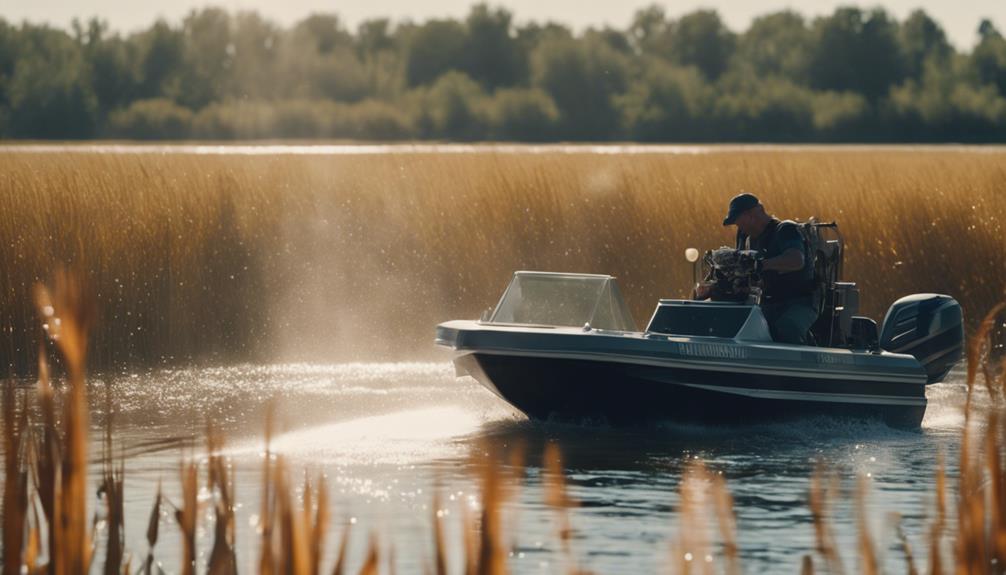
To keep your jet boat performing at its best in shallow waters, regular maintenance is essential. Neglecting maintenance considerations can lead to decreased performance and potential damage. Here's a quick overview of essential maintenance tasks:
| Maintenance Task | Frequency |
|---|---|
| Inspect impeller and jet intake | After each outing |
| Clean jet system | After each outing |
| Engine maintenance | Every 50 hours |
| Check hull for damage | Monthly |
| Monitor fuel levels | Before each use |
Regular inspections of the impeller and jet intake are necessary to prevent debris from clogging the system. After each outing, thoroughly clean the jet system to remove weeds and leaves that can obstruct water flow or damage the impeller. Routine engine maintenance is critical for ensuring longevity, especially since jet boats operate at higher RPMs. Don't forget to check for scratches on the hull, as these can affect water efficiency and lead to grounding in shallow conditions. Finally, keep an eye on your fuel levels and quality to maintain peak performance.
User Experiences and Recommendations
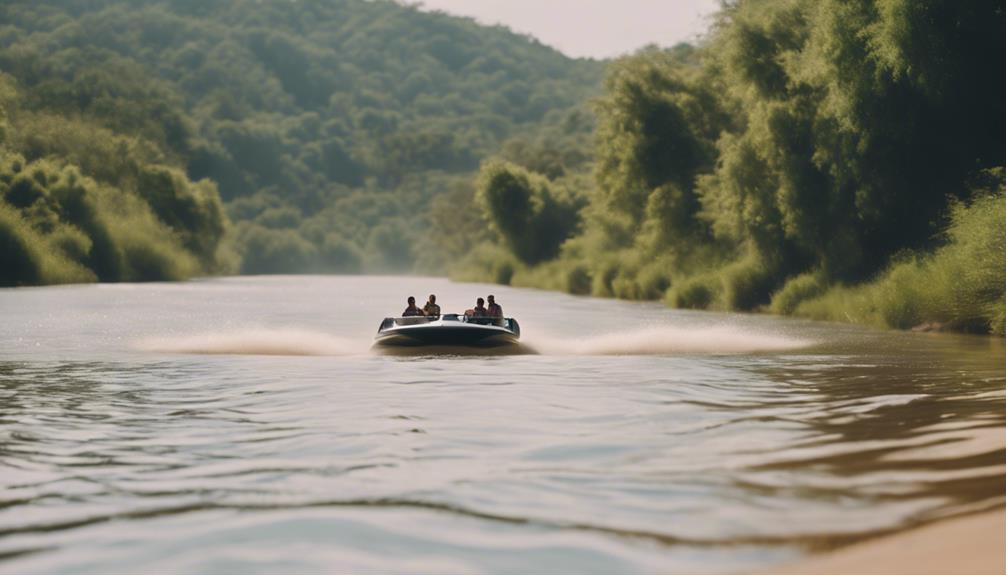
User experiences highlight the advantages of jet boats for maneuvering shallow waters, showcasing their capability to operate in just a few inches of water without damaging the propeller. Many boaters appreciate the versatility of jet boats, particularly in rocky and sandy environments.
Here are some key takeaways from users:
- Jet boats can traverse waters as shallow as 3 inches at full throttle.
- Higher horsepower models are recommended for ideal performance in shallow water.
- Compact engine designs contribute to reduced draft, enhancing maneuverability.
Boaters often recommend jet boats for traversing shallow rivers and lakes, emphasizing their effectiveness in challenging conditions.
However, choosing the right model with sufficient horsepower is vital to avoid grounding issues.
By selecting a jet boat suited for shallow water, you'll enjoy a smooth and adventurous experience on your favorite waterways, allowing you to explore areas that traditional boats can't reach.
You'll find that user feedback consistently points to the reliability and fun factor of jet boats in shallow water settings.
Frequently Asked Questions
Are Jet Boats Good in Shallow Water?
Jet boats excel in shallow water, letting you navigate areas where traditional boats can't. Their minimal draft and powerful maneuverability make them perfect for tight spots, ensuring you enjoy your time on the water without worries.
What Is the Best Watercraft for Shallow Water?
When steering through those tranquil, shallow waters, you'll find jet boats shine brightly. Their nimble design and minimal draft let you explore hidden gems, making them a top choice for your aquatic adventures in tight spaces.
What Are the Downsides of Jet Boats?
Jet boats have downsides, like vulnerability to debris clogging the pump intake, limited nozzle adjustments for varying loads, and tricky maneuverability at low speeds, making docking complicated for inexperienced drivers. Maintenance can also be more frequent.
How Deep of Water Does a Jet Boat Need?
A jet boat needs only about 3 inches of water to operate effectively. With a shallow draft, you can navigate areas where traditional boats struggle, giving you access to more versatile and exciting water adventures.
Can Jet Boats Maneuver in Shallow Waters as Well as They Can for Skiing?
Yes, jet boats for skiing can indeed maneuver in shallow waters as well as they can for skiing. Their shallow draft and unique propulsion system allow them to navigate in shallow water with ease, making them perfect for skiing in rivers and shallow lakes.
Conclusion
So, are jet boats the ultimate champions of shallow water adventures? Absolutely!
With their incredible jet drive mechanism, they glide through the shallows like a dolphin dancing on waves. While they've got a few quirks, the thrill of zipping over hidden obstacles makes every outing an exhilarating experience.
You'll feel like a water wizard!
So, if you're craving unforgettable memories and heart-pounding excitement, a jet boat is your ticket to shallow water bliss! Plunge into it and enjoy!

